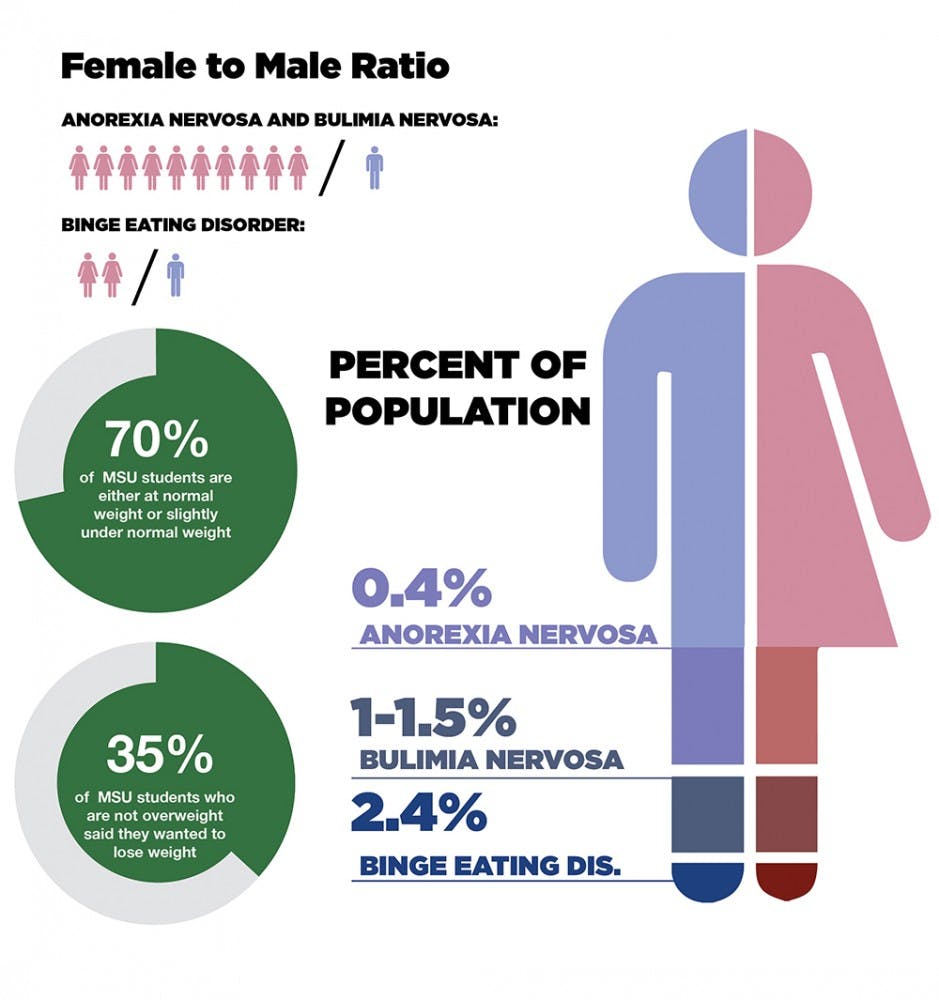As an 8-year-old girl, Jane was encouraged by her father to go outside and play, not for fun, but with the goal of maintaining a healthy weight.
“He said that all the women in our family have had issues with their weight, and he didn’t want that for me,” Jane said. “I was only 8, but it made a huge impact on me.”
Jane, an arts and humanities junior, whose name has been changed for anonymity, said she developed an eating disorder her freshman year of high school because of the pressure she felt to be perfect.
“There’s a lot of social pressure and societal pressure to look a certain way, to feel accepted,” said Anne Buffington, a nutritionist at MSU Student Health Services and a registered dietician.
Jane said she was never clinically diagnosed with an eating disorder, but she had some of the common symptoms of anorexia, such as controlled eating, skipping meals and over-exercising late at night so no one would know.
She suffered in silence for more than a year before telling her parents and getting treatment.
“Because of the stigma that comes with it ... people tend to look at you differently,” she said. “I’d rather people see me as who I am today.” Jane claims that as her reasoning for anonymity, adding that having an eating disorder is something personal she doesn’t want to share with everybody.
Starving self-esteem
Buffington said eating disorders are not about food and weight, but are psychological conditions. They are also not limited to gender or race.
Psychology professor Kelly Klump said there are four different types of eating disorders: anorexia nervosa, bulimia nervosa, binge eating disorder and feeding and eating disorders that are not otherwise classified.
Anorexia nervosa is characterized by restricting food intake to the point of becoming in a starved or semi-starved state, Buffington said. She said the self-esteem of someone who is anorexic is completely based on how they look.
By contrast, bulimia nervosa is when someone binge eats and then purges themselves of the food ingested through vomiting, laxatives or over-exercise, Klump said.
Bulimics also base their self-esteem on their looks, but they have a normal body weight or above and are not extremely thin, she said.
Buffington said binge eating disorder is characterized by eating large volumes of food in a short amount of time, but no purging follows it.
Jane said she knows many people who used to have an eating disorder or currently have one.
The last group deals with eating disorders that don’t meet the criteria for a specific eating disorder, or are some combination of the eating disorders, Buffington said. The prevalence of those disorders is 8-10 percent of the population, Klump said.
However, Klump said people with anorexia often engage in binge eating and purging, and the only difference between anorexia and bulimia is body weight.
Collegiate triggers
Buffington, who specializes in eating disorders, said one could be triggered by a traumatic experience or a major life transition, such as starting college.
Klump said eating disorders are most common among women ages 16 to 25, and there tends to be an increase of clinically significant eating disorders in college.
Buffington said 1 in 3 college women will have struggled with weight, food, body image, disordered eating or an eating disorder by the time they graduate from college.
“It can be difficult in the college environment to handle some of the stresses and complexities that come along with being a college student,” Buffington said.
Jane said her freshman year was particularly stressful and she had a strong urge to start restricting her eating and dieting again, but got through it by talking to a friend who was going through the same thing.
Seventy percent of MSU students report being at or slightly under their normal weight, and 35 percent, who are not overweight, report still trying to lose weight, Buffington said.
Environmental studies and sustainability junior Angie, who has also had her name changed for anonymity, has been binge eating since she was a little kid and started restricting her eating in high school.
She would skip breakfast and lunch, then eat huge portions at dinner. She no longer restricts her food intake, but she still struggles with binging.
“People started noticing that I wasn’t eating at school and they would ask me if I was anorexic,” Angie wrote in an email. “That, in itself, was embarrassing, so when the school year ended, I changed my eating habits.”
A range of causes
Klump said eating disorders can be inherited, and the likelihood of that occurring ranges from 50 to 80 percent. However, she said they are usually triggered by environmental factors, including living in the weight-focused culture of the United States.
Buffington said if someone has a family history of depression, anxiety, or eating disorders, it’s also more likely that person will develop one.
This applies to Jane, as well.
Jane said depression runs in her family, and after she told her parents about her disorder, she said she was diagnosed with depression by her doctor and obsessive-compulsive disorder by a therapist.
“It was more like OCD based on ... thoughts, like forever thinking of the pressures that I need to be perfect ... and how that manifested through controlled eating,” Jane said.
Angie said she became depressed near the end of her sophomore year in high school, and that’s when the restricted eating started.
She said her binging has caused weight gain and stress, and has also led to her developing depression and anxiety.
Once somebody develops an eating disorder, it eventually takes on a life of its own and becomes harder to treat, Klump said.
Jane said people often don’t realize that having an eating disorder isn’t a choice, that it can just happen because of a combination of factors.
Klump said a part of this is difficulties in terms of their cognitive functioning.
“It’s called ... cognitive inflexibility, where they can’t change course,” Klump said. “So, if they’re on a course where ‘I’m on a diet, I must lose weight, I must lose weight,’ now they’re starving. Starvation is going to make it even more difficult for them to shift out of that cognitive set of ‘I must starve myself.’”
Finding treatment
Klump said the best treatment for eating disorders tends to be cognitive behavioral therapy, but anorexia nervosa patients have to gain weight before any kind of therapy becomes effective.
Buffington agrees therapy is crucial and the key component of treatment, but she said a multidisciplinary team of a therapist, medical provider and dietician is best to address all aspects of an eating disorder.
Klump said the best time to get treatment is before they have a full-blown eating disorder, because if they wait treatment will be more difficult and take longer to complete.
Early warning signs of eating disorders are typically increased rigidity, dieting, excessive exercise, vomiting and binge eating, Klump said.
“In high school, the counseling really did help,” Jane said. “I think it was a combination of counseling and medication ... that helped me realize ... not everything has to be perfect, and what I’m doing to myself is unhealthy.”
Angie said she has come to terms with her eating disorder and she recommends others to talk to people they trust to help support them and overcome their eating disorder.
“I haven’t overcome this eating disorder ... and I know that I have to work on it, but honestly, it’s hard,” Angie said.
Buffington said MSU students can get help from Olin Health Center or the Counseling Center on campus if they are struggling with an eating disorder, or just body image and weight in general.
“It takes a lot to change your attitude and to learn to love yourself,” Jane said. “So, you need to know it’s going to be hard, but it’s so worth it.”







